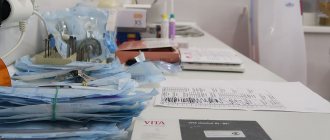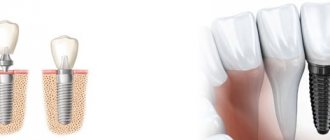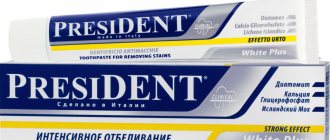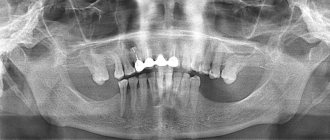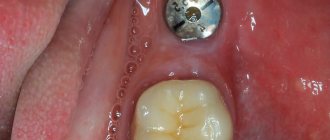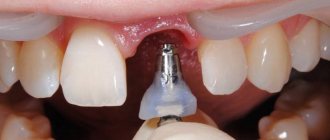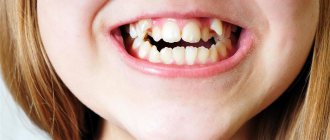What is dental implantation When do you need an alternative How can you replace implants For chewing teeth For front teeth With complete edentia Why do you need to restore teeth Which method is better
Patients are looking for an alternative to implantation due to financial or clinical restrictions on the implantation of artificial roots. Removable dentures (clasp, flexible, acrylic) and fixed products made of metal ceramics, all-ceramic, zirconium (dental bridges) can not fully replace implants. Rarely, missing units are replaced by displacing adjacent ones using braces. The preferred option is implantation: it guarantees an aesthetic, long-term and reliable result, with safety for neighboring units and benefits for the jawbone.
When an alternative to dental implants may be needed
Not everyone can get implantation. Contraindications for surgery:
- mental pathologies;
- immunodeficiency states;
- cancer;
- decompensated diabetes mellitus;
- rheumatism;
- problems with blood clotting;
- diseases of the central nervous system;
- diseases of bone tissue;
- inflammatory processes;
- severe heart pathologies;
- renal failure;
- increased sensitivity to antiseptics;
- age up to 18 years.
The list of contraindications varies depending on the implantation method. In addition to the restrictions on installing titanium roots, implantation has other disadvantages:
- relatively high cost of treatment;
- risk of implant rejection;
- the likelihood of damage to the maxillary sinuses (with prosthetics in the upper jaw row);
- complexity of the operation (the integrity of soft, bone tissue, nerve endings and mucous membranes is damaged - postoperative swelling and pain occur).
When are alternative implantation methods used?
Implantation allows you to restore the dentition by implanting metal structures on which the prosthesis is installed. There are many techniques that allow you to restore your smile in a short time - up to 5 days. However, this method is sometimes contraindicated for a certain category of patients who have a history of:
- autoimmune pathologies;
- tendency to allergic reactions;
- oncology and recovery period after a course of chemotherapy;
- dental pathologies in the acute period;
- severe diabetes mellitus;
- AIDS, tuberculosis.
- diseases of the endocrine system;
- acute period of infectious and inflammatory diseases;
- blood clotting disorder.
Implantation is not recommended for patients who neglect oral care.
Heavy smokers should avoid implantation of metal structures, as a bad habit increases the likelihood of implant rejection.
Deputy Chief physician Sergey Evgenievich Brodsky
Sign up for a free consultation
+7
What can replace dental implantation?
Removable dentures
If the patient does not have money for implants, they make do with removable dentures, which can be inserted and removed from the mouth without the help of a dentist. The type of structure being installed determines the number of lost units:
- there are not several units in a row - partial structures are needed;
- If you need to replace your teeth, a full removable structure will help out.
The design of the removable product is made of plastic pink gums and artificial teeth. The structure includes a metal frame, hooks, and locks. If a complete denture is fixed, due to the gingival base, the product adheres to the mucous membrane (for reliability, patients use fixing creams and gels). The partial denture rests on healthy units with the help of hooks and clasps.
There are types of dentures:
- Bugelnye. The structures are used to restore several elements. They have a metal arc or clasp. The product is durable and can be fixed even on moving teeth. The service life of the structure is 7 years or more. Among the disadvantages, they note: low aesthetic value (fastenings are noticeable), relatively high price of prostheses. Condition for prosthetics: the presence of at least 2 supporting teeth in each row.
- Flexible. Dentures are made from soft hypoallergenic plastics - they are lightweight, comfortable to wear, and fit well to the gums. Partial flexible structures are supplemented with fastenings - plastic hooks. Products last 5-7 years or more. Among the disadvantages, they note: the impossibility of repairing or adjusting the prosthesis in the dentist’s chair (the product is repositioned by a dental technician). When wearing a soft structure, the atrophic process in the bone progresses faster (compared to a hard one).
- Acrylic. Plate structures are made of hard plastics - they are not comfortable to wear. The chewing load will be distributed on the gums, and not on the supporting units. Plus - low cost. Of the minuses, they note: the length of the period of adaptation, methyl ester of methacrylic acid in the composition of acrylic (irritates the mucous membranes).
Fixed dentures
Fixed structures are fixed in the oral cavity - the patient cannot remove them without the help of a dentist. The prosthesis has the form of a single dental crown or complex (dental bridge), which is “put on” the supporting teeth.
Bridge-like products rest on healthy neighboring elements (they are pre-ground). A locking dental bridge in the form of a single crown has a latch inside (the other two are on adjacent teeth). The adhesive structure is fixed to the supporting units, not covering them, but joining the tooth wall (preparation is excluded).
Fixed dentures have the following advantages:
- instantly restore the aesthetics and functionality of the dentition;
- biocompatible, hypoallergenic;
- do not rub the mucous membrane, do not create the sensation of a “foreign body” in the mouth;
- wear-resistant.
The disadvantages of fixed prosthetics include the high price and the need for support in the form of healthy teeth. In the absence of a large number of units, this support can only be implants.
Depending on the material, non-removable products are classified into:
- All-ceramic. The dentures are made of pressed ceramics; they are durable and resistant to chips, scratches and discoloration. The products are successfully used in the restoration of the frontal row.
- Metal-ceramic. One-piece construction consisting of a metal base and a coating in the form of aesthetic porcelain. Durable products can withstand significant loads. An allergic reaction to the metal is possible. Suitable for restoring chewing teeth.
- Zirconium. The basis of the design is zirconium dioxide, the coating is a layer of dental ceramics of a selected tone (similar to enamel). The prosthesis is durable, fits tightly to the supports, CAD/CAM technology guarantees the accuracy of the restoration. The disadvantage of zirconium prostheses is their high cost.
Recover adjacent teeth with braces
An alternative to implants and a bridge to replace the lateral teeth is to move adjacent units to replace the removed ones. The duration of therapy depends on the number of missing teeth and the time the patient walked without them. Treatment can last up to four years.
Before therapy, a thorough diagnosis is carried out and probable changes in the bite are predicted. Possible complications of therapy include resorption of bone tissue and exposure of tooth roots.
Fixed prosthetics
Orthopedic dentistry, developing, has achieved that with the help of fixed dentures it is possible to restore a tooth, obtaining the most “physiological” and aesthetic system. In addition to traditional bridges (remember, in cases where it is possible and advisable to use adjacent teeth as supporting ones), there is, for example, a technique for installing crowns on stump inlays (pin inlays connecting an artificial crown to the natural tooth root).
If there are contraindications for “traditional” (“classical”) implantation, mini-implantation may be an alternative.
For this operation, implants of a smaller diameter (compared to “classical root-shaped” implants) are used. Mini-implant abutments are a single (monolithic) part with the “body” of the implant. Typically, mini-implantation is used for subsequent fixation of a removable structure (for better fixation).
You can contact the most conveniently located clinic of the Healthy Smile network for a consultation, where you will be able to obtain detailed information on this topic.
What is an alternative to implants for chewing teeth?
The chewing elements are more loaded than the anterior ones. The anatomy and localization of the units makes it difficult to care for the elements - the risk of developing dental diseases in the area of chewing teeth is high, the elements are susceptible to destruction.
If one or more teeth are missing in the chewing area, a dental bridge is placed, provided that there is something to attach it to - the adjacent units (including damaged ones) are pre-ground.
Among removable products, the use of a clasp design is justified - a durable option that does not bend under load. The product is secured with hooks or clasps.
Price
Prices for restoration procedures in each clinic depend on the materials used, the qualifications of specialists, and many other factors. In the regions they are usually lower than in the capital.
| Type of dental restoration | average price |
| Placement of one implant with a crown | from 35,000 rub. |
| Replantation | from 1000 rub. |
| Prostheses: | |
| Clasp (depending on the fastening mechanism and the number of teeth) | 8000-90000 rub. |
| Nylon (partial, full) | 7000-20000 rub. |
| Acrylic | from 12,000 rub. |
| Prosthetics on implants: | |
| ALL-ON-4 | from 100,000 rub. |
| ALL-ON-6 | from 200,000 rub. |
| Clasp dentures on implants | 80,000-200,000 rub. |
How to replace implants on front teeth
The frontal elements are not involved in chewing food, but high aesthetic demands are placed on them. As an alternative to implantation, a dental bridge is suitable for restoring teeth in the front row.
Metal-ceramic structures are not used in the smile area: the metal base darkens in the light; upon contact with metal, the mucous membrane may darken. Solid ceramics is a durable material, characterized by natural translucency, and looks like “your own” tooth. The most accurate, aesthetic and durable option is a zirconium dioxide prosthesis.
Are there any contraindications to implantation?
Numerous studies of implantation techniques have shown the existence of a number of contraindications. They are classified into absolute and relative .
The first category includes circumstances in the presence of which the operation is categorically impossible :
- blood diseases (for example, poor clotting);
- diabetes;
- neuropsychiatric disorders;
- malignant processes in the body;
- serious disruption of the immune and endocrine systems;
- diseases that are characterized by difficulty in restoring connective tissue;
- pathologies of the oral mucosa;
- tuberculosis;
- dysfunction of the masticatory muscles.
Relative contraindications cease to be such after treatment. Among them:
- formation of carious cavities;
- inflammatory processes;
- poor oral hygiene;
- malocclusion;
- abnormalities of the jaw bone tissue;
- abuse of alcoholic beverages, drugs, smoking;
- taking medications that affect the nervous system;
- pregnancy, breastfeeding period.
The presence of contraindications does not mean that the problem cannot be solved. There are other options that are often used in modern dentistry and provide good results.
Which method is better to choose?
Implantation is a privileged way to restore lost elements in the absence of financial and clinical restrictions. Advantages of the method:
- Implants are durable. When installing a dental bridge, a replacement will be required after 5-7 years. The service life of implants is at least 25 years .
- Adjacent elements remain untouched. Implants do not require support. When installing a dental bridge, the supporting units are pre-ground, which leads to their destruction.
- Stopping bone atrophy. Implantation guarantees an even chewing load on the jawbone - the bone is not destroyed.
- Preservation of taste sensations. Removable structures dull the sense of taste due to the massive base blocking the receptors.
- Reliable fixation of prostheses and installation of various options for orthopedic structures.
Author of the article Voznyuk Vladimir Aleksandrovich Maxillofacial surgeon-implantologist of the highest category
Experience more than 30 years
Why didn't the implant take root?
Sometimes the cause of rejection is medical errors: incorrect selection of an artificial root, use of a low-quality implant, insufficient qualifications of a doctor, or even the use of faulty equipment. But most often, dental implant replacement is required for other reasons:
- failure to properly follow the doctor’s recommendations by the client;
- reduced patient immunity;
- insufficient quality of oral hygiene before and after surgery;
- injury or acute form of gum disease.
Replantation
Replantation is an operation that involves temporarily removing a tooth, treating the alveolus, and returning the tooth to its place. If the technology is followed, the result will last for 10 years. To perform such an operation, the patient must have a tooth with a completely preserved crown and as straight roots as possible. Replantation is indicated in the following cases:
- if it is impossible to treat periodontitis using classical methods;
- when a tooth is injured during the removal of an adjacent dental unit;
- in case of accidental removal of the “wrong” tooth;
- after jaw injuries.
Installing dental implants is not the only way to give a patient a beautiful smile and restore chewing function. But of all the existing methods, it is implantation that gives long-lasting results, since the titanium root can only be destroyed by injuring the jaw bone.
